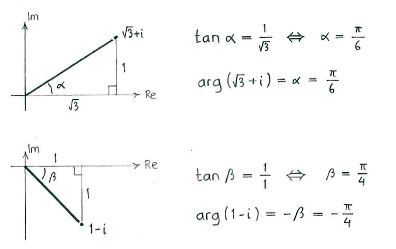Lösung 3.2:5c
Aus Online Mathematik Brückenkurs 2
(Unterschied zwischen Versionen)
K |
|||
| Zeile 1: | Zeile 1: | ||
| - | Geometrically, the multiplication of two complex numbers means that there magnitudes are multiplied and their arguments are added. The product | + | Geometrically, the multiplication of two complex numbers means that there magnitudes are multiplied and their arguments are added. The product <math>(\sqrt{3}+i)(1-i)</math> therefore has an argument which is the sum of the argument for the <math>\sqrt{3}+i</math> and <math>1-i</math>, i.e. |
| - | <math> | + | |
| - | therefore has an argument which is the sum of the argument for the | + | |
| - | <math>\sqrt{3}+i</math> | + | |
| - | and | + | |
| - | <math>1-i</math>, i.e. | + | |
| + | {{Displayed math||<math>\arg \bigl((\sqrt{3}+i)(1-i)\bigr) = \arg (\sqrt{3}+i) + \arg (1-i)\,\textrm{.}</math>}} | ||
| - | + | By drawing the factors in the complex plane, we can determine relatively easily the argument using simple trigonometry. | |
| - | + | ||
| - | + | ||
| - | By drawing the factors in the complex plane, we can determine relatively easily the argument using simple trigonometry | + | |
| - | + | ||
[[Image:3_2_5_c.gif|center]] | [[Image:3_2_5_c.gif|center]] | ||
| - | + | (Because <math>1-i</math> lies in the fourth quadrant, the argument equals | |
| - | (Because | + | <math>-\beta</math> and not <math>\beta</math>.) |
| - | <math>1-i</math> | + | |
| - | lies in the fourth quadrant, the argument equals | + | |
| - | <math>-\beta </math> | + | |
| - | and not | + | |
| - | <math>\beta </math>.) | + | |
Hence, | Hence, | ||
| + | {{Displayed math||<math>\arg \bigl((\sqrt{3}+i)(1-i)\bigr) = \arg (\sqrt{3}+i) + \arg (1-i) = \frac{\pi}{6} - \frac{\pi}{4} = -\frac{\pi}{12}\,\textrm{.}</math>}} | ||
| - | <math>\begin{align} | ||
| - | & \arg \left( \left( \sqrt{3}+i \right)\left( 1-i \right) \right)=\arg \left( \sqrt{3}+i \right)+\arg \left( 1-i \right) \\ | ||
| - | & =\frac{\pi }{6}-\frac{\pi }{4}=-\frac{\pi }{12} \\ | ||
| - | \end{align}</math> | ||
| - | |||
| - | |||
| - | NOTE: if you prefer to give the argument between | ||
| - | <math>0</math> | ||
| - | and | ||
| - | <math>2\pi </math>, then the answer is | ||
| + | Note: If you prefer to give the argument between <math>0</math> and <math>2\pi </math>, then the answer is | ||
| - | <math>-\frac{\pi }{12}+2\pi =\frac{-\pi +24\pi }{12}=\frac{23\pi }{12}</math> | + | {{Displayed math||<math>-\frac{\pi}{12}+2\pi = \frac{-\pi+24\pi}{12} = \frac{23\pi}{12}\,\textrm{.}</math>}} |
Version vom 12:39, 29. Okt. 2008
Geometrically, the multiplication of two complex numbers means that there magnitudes are multiplied and their arguments are added. The product \displaystyle (\sqrt{3}+i)(1-i) therefore has an argument which is the sum of the argument for the \displaystyle \sqrt{3}+i and \displaystyle 1-i, i.e.
| \displaystyle \arg \bigl((\sqrt{3}+i)(1-i)\bigr) = \arg (\sqrt{3}+i) + \arg (1-i)\,\textrm{.} |
By drawing the factors in the complex plane, we can determine relatively easily the argument using simple trigonometry.
(Because \displaystyle 1-i lies in the fourth quadrant, the argument equals \displaystyle -\beta and not \displaystyle \beta.)
Hence,
| \displaystyle \arg \bigl((\sqrt{3}+i)(1-i)\bigr) = \arg (\sqrt{3}+i) + \arg (1-i) = \frac{\pi}{6} - \frac{\pi}{4} = -\frac{\pi}{12}\,\textrm{.} |
Note: If you prefer to give the argument between \displaystyle 0 and \displaystyle 2\pi , then the answer is
| \displaystyle -\frac{\pi}{12}+2\pi = \frac{-\pi+24\pi}{12} = \frac{23\pi}{12}\,\textrm{.} |

